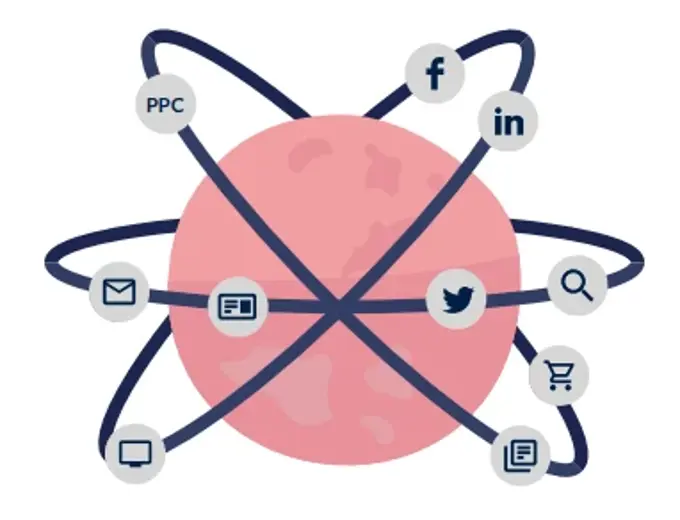What is a composable DXP?
A Composable DXP is a digital experience platform that consists of a series of “best-of-breed” modules approach to how they are integrated. They work together through API and microservices with a headless approach.
The composable DXP is a “Pick what you want” digital solution. This approach means that the functionality consists of different software pieces with individual packaged-business-capabilities (PBCs) like eCommerce, personalization, search, A/B testing and CRM.
Digital experience platforms are not something new. But until recently, they have mainly been monolithic DXPs, where everything was packed into one system from one software vendor, not necessarily the best pieces of software.
What is a monolith DXP?
The monolithic approach to a DXP setup is the traditional approach where one software vendor will sell a prepackaged all-in-one software suite.
All the functionality is available from the same suite, but this also means if you don’t need a feature that is not there or want to change to another provider, this is often not possible.
Read more about the monolith DXP here.
When it comes down to Digital experience platforms, there are two different approaches. A monolithic DXP and a composable DXP. But which one should you choose?
The answer to the question depends on your requirements for the tech stack and your existing setup. With the monolithic approach to your DXP, you will have everything integrated into an all-in-one platform with one vendor.
On the opposite side, there’s the composable DXP based on microservices and a modular approach with best-of-breed applications, where you can pick and choose the tools you need and want.
Read on here if you want more in-depth knowledge about composable DXP vs. monolith DXP.
A Composable DXP is built on the idea of modularity. The modules will each offer functionality that can be reused and updated as needed through APIs and microservices.
This approach to software architecture makes it easier for businesses to create and manage digital experiences that meet the needs of their customers. With Composable DXP, companies can quickly adapt to changing customer needs and preferences, delivering a more personalized experience that meets their needs.


Decoupling with composable DXP
Composable DXP also offers the benefit of decoupling. Decoupling is the process of separating content from presentation. Decoupling means that content is stored in one place, while the presentation of the content to the end-user can happen on any platform connected to the DXP setup.
The rise of Headless CMS has been an enabler for the Composable DXP approach. In addition, the Headless CMS serves as a content provider, where you don’t have to worry about the presentation of the content no matter which platform it’s displayed on.
The Benefits of Composable DXP
But why has composable DXP started to be the talk of the town?
With the composable approach to your DXP, you can choose only the functionality and software you want and need to implement when your company is ready for it. In addition, the software is usually from different vendors. This allows you to choose only the software you need and the software that fits your business - not the other way around.
From a more technical perspective, the solution is built from various systems connected with APIs and microservices. The benefit of this approach is that you can integrate already existing systems within your business.
If you're looking for a more flexible and adaptable digital experience platform, Composable DXP is the right choice for your business. With Composable DXP, you can quickly adapt to changing customer needs and preferences, delivering a more personalized experience that meets their needs. Contact us today to learn more about Composable DXP and how it can benefit your business.
Why choose a composable DXP?
Why is there so much fuzz about the composable DXP these days? One of the reasons is the benefits that composable architecture can contribute to your business. Here are just a few of the advantages of a composable DXP.
It’s flexible
With the ever-increasing pace, the tech landscape is changing, and businesses need to be flexible.
The composable DXP brings flexibility to businesses so they can avoid vendor lock-in, as is often the case with a monolithic DXP.
A composable DXP is flexible and integrates the technologies to create the best customer experience, whether it’s a new marketing automation engine, CRM, or campaign management. If your business has further requirements that your existing tech stack can’t live up to, you are free to integrate with new software that will fulfill that requirement.
It’s customizable:
Due to its composable architecture, the composable DXP is flexible, And businesses greatly benefit from this as they do not need to base their strategy around the platforms they use. Instead, you can customize every aspect of the tech stack to meet the requirements of your business strategy.
It puts the customer first.
The composable DXP is customer-centric and does not try to force customers into predefined journeys from the software vendor.
With a composable DXP approach, organizations can apply better customer data and control every touchpoint, thus serving excellent customer experiences.
It can be implemented faster.
With a composable approach to your DXP setup, you can implement new elements or parts of the system faster.
Regarding development, the developers can use their favorite framework to implement and build their setup. This approach means that development time and the training required are significantly reduced.
The composable DXP enables developers and marketers to build great web experiences, personalization, scale, test, and make adjustments based on data insights without being slowed down by development or training.
Composable architecture
In the tech sphere, you will see acronyms always spring up. And the composable DXP-sphere has a few. However, when it comes to the architecture in Compoasble DXP, we have to talk about MACH architecture.
What Is MACH?
MACH stands for microservices, API-first, Cloud-native, and Headless architecture; They are the cornerstones for creating a composable DXP for the backend part of the platform. Let's have a look at what they are;
Microservices are combined small modular services that form an application.
API-first is the approach to how the software is structured. The application's functionality is exposed using APIs, allowing integration with other best-of-breed software.
Cloud-native SaaS is how the software is deployed. This means upgrades, maintenance and scaling are handled from one central point.
Headless means that the front and the backend are decoupled, and content is served through APIs to different functions and devices that are part of the entire DXP platform. Read on here if you want to dive further into Headless CMS.
Umbraco CMS as part of your Composable DXP Solution
Umbraco is an excellent fit for composable DXP setups as they need a CMS as part of their core functionality, and a headless CMS is one of the first things you should look into.
With Umbraco, you can manage and edit your content in an editor-friendly way. You can use our open-source version or our headless version of our CMS, Umbraco Heartcore.
Umbraco Heartcores is built on our open-source version of the Umbraco CMS. It’s packaged as a managed and hosted SaaS (Software-as-a-Service) solution.
Use our open RESTful APIs and GraphQL that you can connect to the frontend of your choice. And with Cloudflare CDN included and a managed API, you don't have to worry about maintaining another codebase or API.
Feel free to book a demo if you want to see Umbraco in action, and how it can be used for your DXP